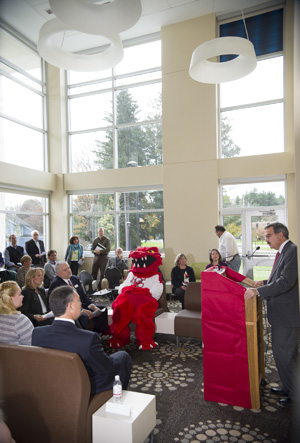Bulletin News

11/11/2013
Elizabeth Church-Peters is tickled red and white — SUNY Cortland’s colors — about her new home on the campus, Dragon Hall.
“I’m proud to call this my home away from home,” declared the musical theatre major from Wampsville, N.Y., while standing at a podium during the facility’s grand opening on Oct. 24.
That afternoon the main lounge of SUNY Cortland’s 16th residence hall was packed full of building contractors and SUNY Cortland students, faculty and staff who gathered to celebrate the historic event with Church-Peters.
Sponsored by the President’s Office, Residence Life and Housing Office, Facilities Management Office and the Division of Institutional Advancement, the program began with a welcome and remarks by College officials and other dignitaries and continued with a ribbon-cutting ceremony, reception and tour of the building.
 |
| Elizabeth Church-Peters, left, shows off her new digs to former SUNY Cortland President James M. Clark, right, and his wife, Patricia, center. Behind them, from the left, are Robert Haight, executive director of the Cortland Chamber of Commerce, and a representative of the Governor’s office. |
During her remarks, Church-Peters said another color also comes to mind when she considers her experience as an occupant in what to date is the most environmentally sustainable finished building on campus.
“There’s something else that makes this residence hall so special, and that’s because it’s green,” she said.
Constructed by LP Ciminelli, Dragon Hall is the College’s first facility to be built to a higher industry standard for green construction. SUNY Cortland is pursuing the U.S. Green Building Council’s gold rating level for Leadership in Energy and Environmental Design (LEED) certification.
Glass Tower Hall, the last new residence hall completed eight years ago, launched the College’s push for energy conservation by attaining a certified LEED designation. Dragon Hall strives to be a cut above that in reducing its carbon footprint, as the structure was designed to earn even more points toward the higher, gold LEED certification.
Erected over a brownfield, the site of a demolished former residence hall structure, rather than on undeveloped land, Dragon Hall demonstrates natural resource conservation, Church-Peters observed.
“It takes some getting used to, but the hallway lights dim and then come back up when the corridors are used,” the first semester transfer student said. She was referring to a new, zoned lighting feature that uses occupancy sensors to turn down the lights in public spaces when no one’s around.
Church-Peters informed the crowd that 23 percent of the building’s materials were natural or recycled and were harvested or produced within 500 miles of Cortland.
The plumbing system uses 42 percent less water, saving a great deal of that resource.
Students moved into Dragon Hall in late August when the semester started. The $22 million facility houses 229 occupants and a hall director. The building is attached to Hayes and Hendrick halls, located near Casey and Smith towers on Neubig Road. The students live on the ground floor through fourth floors in quad-style rooms with shared floor lounges and kitchens.
The building is fully accessible, and each floor has a unit that features complete access. All remaining suites may be modified readily for accessibility as well.
 |
| Three students opened their roomfor an afternoon to gazing eyes of guests come to celebrate Dragon Hall's grand opening. |
Additional energy saving features include:
• an array of rooftop solar panels designed to offset about 8 percent of the building’s annual electricity use;
• a new, highly effective type of heat-conserving insulation that gives the building a 43.6 percent better energy performance than the national baseline by which similar facilities are measured;
• a computer system programmed to manage energy use and engage all residents in conservation;
• insulated, double-pane windows that contain louver blinds inside them;
• outside metal solar shades to block the most intense rays of the sun; and,
• very bright and long-lasting, light-emitting diode (LED) fixtures that have replaced the former benchmark in energy-saving lighting, compact fluorescent lamps.
The New York State Energy Research and Development Authority (NYSERDA) will grant the College an approximately $35,000 rebate as an incentive for installing the solar array feature. NYSERDA also conducted a whole-building assessment of Dragon Hall’s energy efficiency and will cut a rebate check for about $103,000 in addition to the solar panel rebate.

